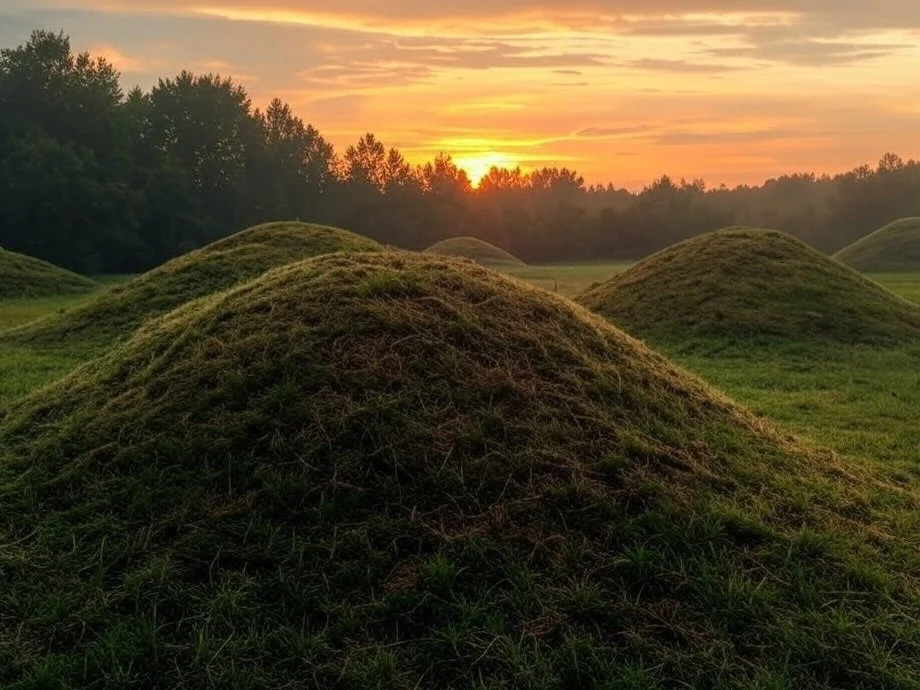Introduction
Burial mounds, also known as tumuli in Europe and kurgans in Central Asia, are among the most enduring and evocative monuments left by prehistoric societies. These earthen or stone structures, often containing human remains and grave goods, provide a window into the social hierarchies, religious beliefs, and cultural practices of ancient peoples. This exploration delves into the characteristics of burial mounds from various cultures, examines what they reveal about ancient societies, and discusses the methods used to study them.
Burial Mounds Across Cultures
Europe: Tumuli
Description: Tumuli are widespread across Europe, with notable examples including the Tumulus of Bougon in France and the burial mounds of the Wessex culture in England.
Construction: These mounds vary in size and complexity, from simple earthen barrows to elaborate structures with stone chambers and passageways.
Contents: Tumuli often contain single or multiple burials, accompanied by grave goods such as pottery, weapons, jewelry, and tools.
Cultural Significance: The presence of rich grave goods and the labor-intensive construction of large tumuli suggest the existence of social hierarchies, with elite individuals receiving more elaborate burials.
Central Asia: Kurgans
Description: Kurgans are prominent in the steppes of Central Asia, particularly associated with the Scythians and other nomadic cultures.
Construction: Kurgans typically consist of a large mound of earth or stone, sometimes surrounded by a circular ditch or additional smaller mounds.
Contents: These burial mounds often contain the remains of high-status individuals, along with horses, chariots, weapons, and intricate gold artifacts.
Cultural Significance: The elaborate nature of kurgans reflects the importance of warrior elites and the role of horses in nomadic societies. The inclusion of horses and chariots underscores the significance of mobility and warfare.
North America: Mound Builders
Description: The Mound Builders of North America, including the Adena, Hopewell, and Mississippian cultures, constructed various types of burial mounds.
Construction: These mounds range from conical shapes to complex geometric forms, such as the Serpent Mound in Ohio.
Contents: Burial mounds in North America often contain human remains, ceremonial objects, and artifacts made from exotic materials, indicating extensive trade networks.
Cultural Significance: The construction of large mounds and the presence of exotic goods suggest the existence of complex social structures and religious practices centered around ancestor worship and cosmology.
Insights into Ancient Social Hierarchies
Elite Burials and Social Stratification:
The presence of richly furnished graves within large burial mounds indicates the existence of social stratification. Elite individuals, such as chieftains, warriors, and religious leaders, were often interred with valuable goods, reflecting their high status and the resources at their disposal.
Labor and Resource Mobilization:
The construction of large burial mounds required significant labor and resources, suggesting the ability of ancient societies to mobilize and organize large groups of people. This capability points to centralized authority and complex social organization.
Symbolism and Power:
Burial mounds served as powerful symbols of authority and continuity. The monumental nature of these structures would have reinforced the social and political power of the elites, while also serving as focal points for communal rituals and memory.
Insights into Ancient Rituals and Beliefs
Ancestor Worship and Veneration:
Burial mounds often functioned as sites for ancestor worship, where the deceased were venerated and remembered. Rituals performed at these sites would have reinforced social cohesion and cultural identity.
Religious and Cosmological Beliefs:
The orientation, design, and contents of burial mounds reflect the religious and cosmological beliefs of ancient societies. For example, the alignment of mounds with celestial events suggests an understanding of astronomy and its integration into spiritual practices.
Funerary Practices and Afterlife Beliefs:
The inclusion of grave goods, such as weapons, jewelry, and food, indicates beliefs in an afterlife where the deceased would require these items. The diversity of grave goods also provides insights into the daily lives, occupations, and statuses of the buried individuals.
Methods of Studying Burial Mounds
Archaeological Excavation:
Systematic excavation of burial mounds reveals the structure, contents, and context of the burials. Careful documentation of stratigraphy and artifacts helps reconstruct the burial practices and social organization of ancient societies.
Radiocarbon Dating:
Radiocarbon dating of organic materials, such as human remains and wooden artifacts, provides chronological information about the construction and use of burial mounds.
Geophysical Survey:
Non-invasive geophysical techniques, such as ground-penetrating radar and magnetometry, allow researchers to map the internal features of burial mounds without extensive excavation.
Osteological Analysis:
The study of human remains provides information on age, sex, health, and diet, offering insights into the demographics and lifestyles of the buried individuals.
Artifact Analysis:
Detailed analysis of grave goods, including typology, material composition, and craftsmanship, helps identify trade networks, technological advancements, and cultural influences.
Conclusion
Ancient burial mounds are more than just resting places for the dead; they are profound expressions of the social, religious, and political lives of prehistoric societies. Through the study of these monumental structures, archaeologists gain valuable insights into the complexities of ancient social hierarchies, the mobilization of labor and resources, and the rich tapestry of rituals and beliefs that shaped human history. As research techniques continue to advance, the secrets of these ancient burial mounds will further illuminate the lives and legacies of the peoples who built them.







